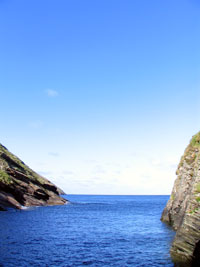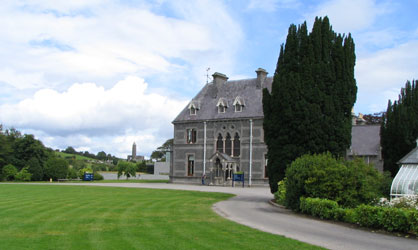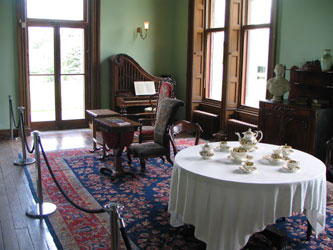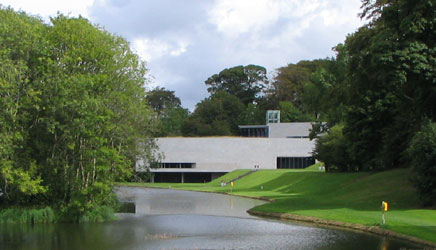 |
Turlough, Co. Mayo |
|
  The other day I decided to go for a drive. I got into my head that I've never been to Belmullet and it might be fun to go have a look-see. For those of you unfamiliar with Irish Geography, Belmullet sits on the far western coast of Ireland with nothing but big sky and cold ocean to the west of it. The round trip from my house is about 700 kilometers, but I enjoy driving and have always had something of a lunatic streak. The other day I decided to go for a drive. I got into my head that I've never been to Belmullet and it might be fun to go have a look-see. For those of you unfamiliar with Irish Geography, Belmullet sits on the far western coast of Ireland with nothing but big sky and cold ocean to the west of it. The round trip from my house is about 700 kilometers, but I enjoy driving and have always had something of a lunatic streak.
As I was scything my way westwards through County Mayo in the general direction of Castlebar, I started passing signposts for the Museum of the Irish Countryside. "Who would pay good money to see a couple of old tractors and some rusty turf spades in a damp-smelling barn?", I thought to myself somewhat cynically. Since I'm trying to be a less cynical human being these days and since the object of my day was to have a wander, I decided I would take up the invitation and give it a go. I have to say I was wonderfully surprised and disabused of my earlier uncharitable preconceptions. For a start, the Museum of the Irish Countryside is actually a facility of the National Museum of Ireland. I was unaware that they had anything closer to the countryside than Collins Barracks in Dublin 7, but there it was. The museum encompasses Turlough Park House, a traditional Irish 'Big House' as well as a brand new purpose built museum building in the grounds.  The Big House is where the local lord of the manor would have lived (or more accurately would have lived if he ever bothered visiting from his London residence). It's also where the local peasantry would have come, cap literally in hand, to pay the rent to the Estate Agent. It looks lovely and impressive if you're not a peasant tenant farmer and it looks horribly scary and intimidating if you are. My family were too poor to be subsistence farmers so it held no nasty folk memories for me. Mind you, the way Dublin property prices are these days, I could probably afford to buy someplace like this if we ever decided to leave Three Rock Mansion and migrate west. But I digress - this house is owned by the National Museum (so in a sense I've already paid to buy it) and they've done a wonderful job in displaying it in its pomp and splendour. The Big House is where the local lord of the manor would have lived (or more accurately would have lived if he ever bothered visiting from his London residence). It's also where the local peasantry would have come, cap literally in hand, to pay the rent to the Estate Agent. It looks lovely and impressive if you're not a peasant tenant farmer and it looks horribly scary and intimidating if you are. My family were too poor to be subsistence farmers so it held no nasty folk memories for me. Mind you, the way Dublin property prices are these days, I could probably afford to buy someplace like this if we ever decided to leave Three Rock Mansion and migrate west. But I digress - this house is owned by the National Museum (so in a sense I've already paid to buy it) and they've done a wonderful job in displaying it in its pomp and splendour.
The real gem of the museum is the new building. Opened in 2001, it is spread over three levels down grassy bank. You enter through the top level and descend gradually through the museum down to the level of the nearby lake, in much the same way as the Luxembourg City History Museum takes you down to the Grund, magically dumping you out in a completely different part of the town. This building houses the National Museum's Folklife collection which depicts how the Irish lived from 1850 to 1950. It ranges from a copy of the arrest warrant for Charles Stewart Parnell to photos of young Irish at dances in Kilburn in the fifties - the lovely girls all bedecked with horn-rimmed glasses and prim cardigans, while young bucks with greased-back hair & wearing the good suit hover nervously in the background.  The best part about the museum though is the way the artifacts are displayed. Wherever possible they're just sitting in front of you rather than entombed behind glass. Obviously the visitor is asked not to touch, but isn't suspiciously monitored as a potential thief. You'ld have a job pilfering a twelve foot currach though and I'm guessing there's limited black market interest in the thatched roof samples. These are simple peasant artifacts, not items of huge intrinsic value. The best part about the museum though is the way the artifacts are displayed. Wherever possible they're just sitting in front of you rather than entombed behind glass. Obviously the visitor is asked not to touch, but isn't suspiciously monitored as a potential thief. You'ld have a job pilfering a twelve foot currach though and I'm guessing there's limited black market interest in the thatched roof samples. These are simple peasant artifacts, not items of huge intrinsic value.
The thing that struck me however was how many of these artifacts I remember from my childhood holidays in Donegal - the thatched cottage divided into living quarters and animal byre. The fire in the hearth constantly kept going, a crane supporting big black pots to keep water boiled, whether for cooking or washing. The harvesting of reeds from the local lake to repair the thatch. The regional forms of St. Brigid's cross. The use of a tongs as a protection from evil. The various patterns of Aran jumper. Simple things distantly remembered, but they set off all sorts of reminiscences. Proust had his soggy Madelaine biscuit, I guess I have the smell of burning turf. |